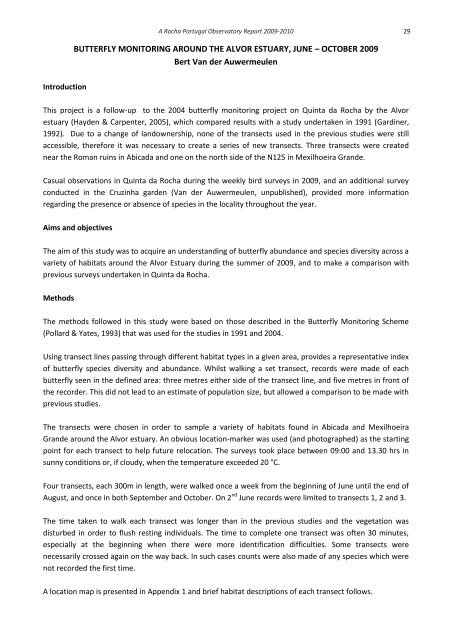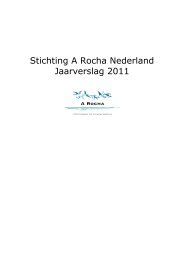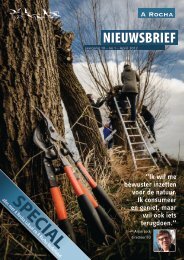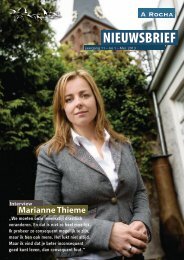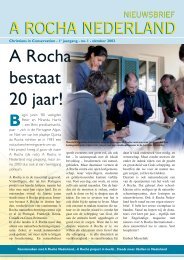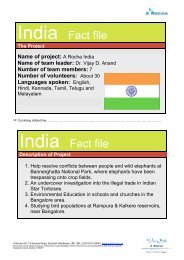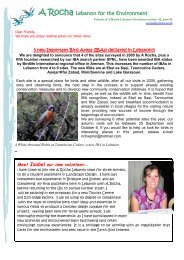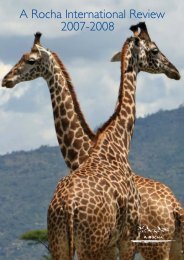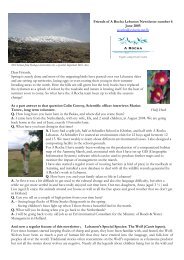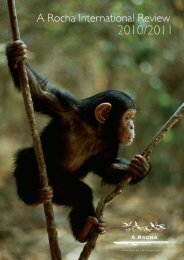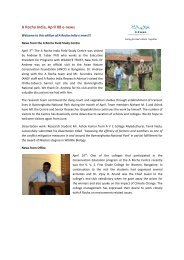A Rocha Portugal Observatory Report 2009-2010
A Rocha Portugal Observatory Report 2009-2010
A Rocha Portugal Observatory Report 2009-2010
You also want an ePaper? Increase the reach of your titles
YUMPU automatically turns print PDFs into web optimized ePapers that Google loves.
Introduction<br />
A <strong>Rocha</strong> <strong>Portugal</strong> <strong>Observatory</strong> <strong>Report</strong> <strong>2009</strong>-<strong>2010</strong> 29<br />
BUTTERFLY MONITORING AROUND THE ALVOR ESTUARY, JUNE – OCTOBER <strong>2009</strong><br />
Bert Van der Auwermeulen<br />
This project is a follow-up to the 2004 butterfly monitoring project on Quinta da <strong>Rocha</strong> by the Alvor<br />
estuary (Hayden & Carpenter, 2005), which compared results with a study undertaken in 1991 (Gardiner,<br />
1992). Due to a change of landownership, none of the transects used in the previous studies were still<br />
accessible, therefore it was necessary to create a series of new transects. Three transects were created<br />
near the Roman ruins in Abicada and one on the north side of the N125 in Mexilhoeira Grande.<br />
Casual observations in Quinta da <strong>Rocha</strong> during the weekly bird surveys in <strong>2009</strong>, and an additional survey<br />
conducted in the Cruzinha garden (Van der Auwermeulen, unpublished), provided more information<br />
regarding the presence or absence of species in the locality throughout the year.<br />
Aims and objectives<br />
The aim of this study was to acquire an understanding of butterfly abundance and species diversity across a<br />
variety of habitats around the Alvor Estuary during the summer of <strong>2009</strong>, and to make a comparison with<br />
previous surveys undertaken in Quinta da <strong>Rocha</strong>.<br />
Methods<br />
The methods followed in this study were based on those described in the Butterfly Monitoring Scheme<br />
(Pollard & Yates, 1993) that was used for the studies in 1991 and 2004.<br />
Using transect lines passing through different habitat types in a given area, provides a representative index<br />
of butterfly species diversity and abundance. Whilst walking a set transect, records were made of each<br />
butterfly seen in the defined area: three metres either side of the transect line, and five metres in front of<br />
the recorder. This did not lead to an estimate of population size, but allowed a comparison to be made with<br />
previous studies.<br />
The transects were chosen in order to sample a variety of habitats found in Abicada and Mexilhoeira<br />
Grande around the Alvor estuary. An obvious location-marker was used (and photographed) as the starting<br />
point for each transect to help future relocation. The surveys took place between 09:00 and 13.30 hrs in<br />
sunny conditions or, if cloudy, when the temperature exceeded 20 °C.<br />
Four transects, each 300m in length, were walked once a week from the beginning of June until the end of<br />
August, and once in both September and October. On 2 nd June records were limited to transects 1, 2 and 3.<br />
The time taken to walk each transect was longer than in the previous studies and the vegetation was<br />
disturbed in order to flush resting individuals. The time to complete one transect was often 30 minutes,<br />
especially at the beginning when there were more identification difficulties. Some transects were<br />
necessarily crossed again on the way back. In such cases counts were also made of any species which were<br />
not recorded the first time.<br />
A location map is presented in Appendix 1 and brief habitat descriptions of each transect follows.


